Production line software can be an important part of automating a manufacturing plant, and choosing the best software can make automation easy or difficult. If you have delicate items or items that need to be processed at different speeds, then a speed adjustment tool should be useful. When an item is produced, it sometimes is made incorrectly and is not able to be sold; if the production line software has a pass and fail tool, then it can automatically reject incorrect items. Most production lines change every few months or years, so a drag-and-drop interface with the production line software should make it easier to adapt to the new production line. Power consumption should be low to keep operational costs low.
Most manufacturing plants produce many different items; while some plants may have items that can all be produced at the same speed, this usually is not the case. To ensure that no items are rushed, cracked or moving too slowly, production line software should include a speed adjustment tool. This usually will enable you to change the production speed per item or per machine.

It is not unheard of during production for an item to be malformed, broken or otherwise incorrect. One way of fixing this issue is by allowing both the correct and incorrect items to reach human employees, who physically check the items for proper production, but human workers may miss bad items. If the production line software has a pass or fail tool, then it can check the item and any bad items will be rejected. Items can be checked by camera, on a scale or by many other methods.
The production line will change as a business evolves. There may be more machines, a longer conveyor belt or even moving to a new manufacturing plant location. During these changes, the production line software may have to adapt to the new conditions, which may force you to type extensive programming to ensure the software works properly. If the software has a drag-and-drop interface that allows you to easily use common programming code just by dragging a tool, then this can make the changes much easier.
As with most of the other tools in a manufacturing plant, production line software will take up power. A program that takes up a lot of power can dramatically increase operational costs. This means that getting a low-powered variant normally is best. This variant also tends to create less heat.
